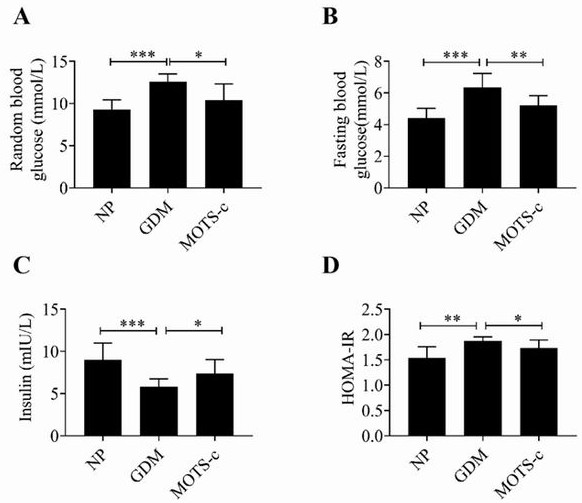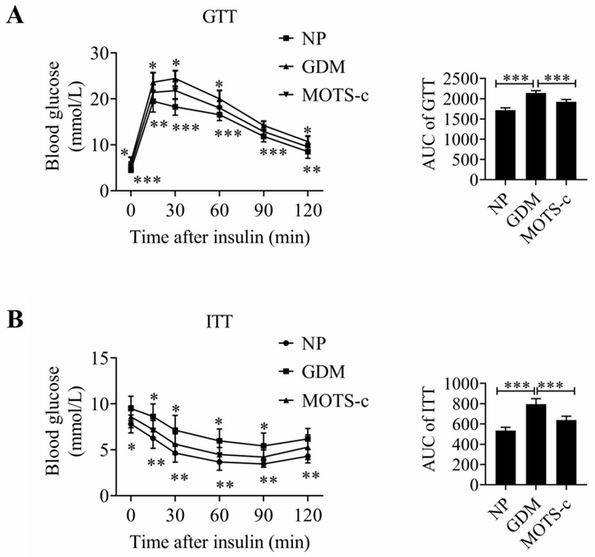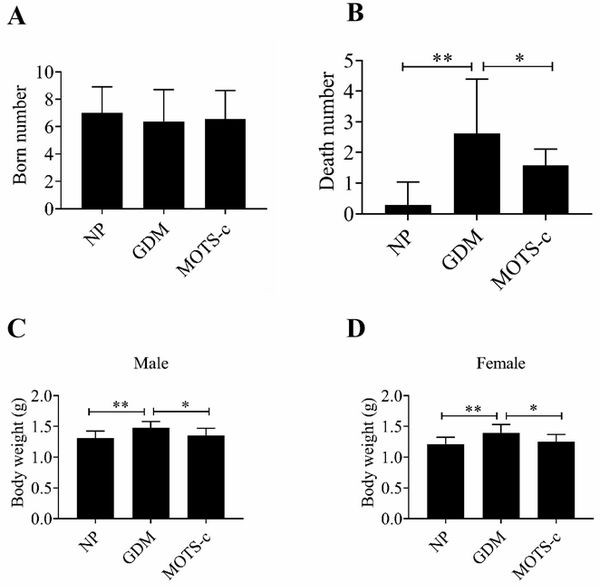Application of MOTS-c peptide and derivative thereof in preparation of medicine for treating gestational diabetes mellitus
A technology of peptide derivatives and therapeutic drugs, which is applied in the field of biomedicine to reduce blood sugar levels, protect structure and function damage, and enhance insulin sensitivity and glucose tolerance
- Summary
- Abstract
- Description
- Claims
- Application Information
AI Technical Summary
Problems solved by technology
Method used
Image
Examples
Embodiment 1
[0031] Effects of MOTS-c on blood glucose and insulin resistance in GDM mice
[0032] experimental method
[0033] C57BL / 6 mice aged 6-8 weeks were used as the research objects, and the experiment was carried out after one week of acclimatization in the SPF animal room. Male mice were fed with normal diet, and female mice were fed with high-fat diet (60% fat). After 4 weeks of continuous feeding, female: male mice were placed in a cage at a ratio of 2:1. Streptozotocin (STZ, 30 mg / kg) was injected intraperitoneally every 24 hours for 3 consecutive injections; the random blood glucose of the mice was measured on the 5th day of pregnancy, and those with random blood glucose ≥ 11.1 mmol / L were considered successful in modeling. The GDM model mice were randomly divided into GDM group and MOTS-c group. The MOTS-c group was injected intraperitoneally with 10 mg / kg MOTS-c solution (MOTS-c dissolved in normal saline) every day, and the normal pregnancy group (NP) and the GDM group we...
Embodiment 2
[0037] Effects of MOTS-c on insulin sensitivity and glucose tolerance in GDM mice
[0038] experimental method
[0039]C57BL / 6 mice aged 6-8 weeks were used as the research objects, and the experiment was carried out after one week of acclimatization in the SPF animal room. Male mice were fed with normal diet, and female mice were fed with high-fat diet (60% fat). After 4 weeks of continuous feeding, female: male mice were placed in a cage at a ratio of 2:1. Streptozotocin (STZ, 30 mg / kg) was injected intraperitoneally every 24 hours for 3 consecutive injections; the random blood glucose of the mice was measured on the 5th day of pregnancy, and those with random blood glucose ≥ 11.1 mmol / L were considered successful in modeling. The GDM model mice were randomly divided into GDM group and MOTS-c group. The MOTS-c group was injected intraperitoneally with 10 mg / kg MOTS-c solution (MOTS-c dissolved in normal saline) every day, and the normal pregnancy group (NP) and the GDM grou...
Embodiment 3
[0043] The effect of MOTS-c on the birth weight of offspring of GDM mice
[0044] experimental method
[0045] C57BL / 6 mice aged 6-8 weeks were used as the research objects, and the experiment was carried out after one week of acclimatization in the SPF animal room. Male mice were fed with normal diet, and female mice were fed with high-fat diet (60% fat). After 4 weeks of continuous feeding, female: male mice were placed in a cage at a ratio of 2:1. Streptozotocin (STZ, 30 mg / kg) was injected intraperitoneally every 24 hours for 3 consecutive injections; the random blood glucose of the mice was measured on the 5th day of pregnancy, and those with random blood glucose ≥ 11.1 mmol / L were considered successful in modeling. The GDM model mice were randomly divided into the GDM group and the MOTS-c group. The MOTS-c group was injected intraperitoneally with 10 mg / kg MOTS-c solution (MOTS-c, dissolved in normal saline) every day. The normal pregnancy group (NP) and the GDM group ...
PUM
 Login to View More
Login to View More Abstract
Description
Claims
Application Information
 Login to View More
Login to View More - R&D
- Intellectual Property
- Life Sciences
- Materials
- Tech Scout
- Unparalleled Data Quality
- Higher Quality Content
- 60% Fewer Hallucinations
Browse by: Latest US Patents, China's latest patents, Technical Efficacy Thesaurus, Application Domain, Technology Topic, Popular Technical Reports.
© 2025 PatSnap. All rights reserved.Legal|Privacy policy|Modern Slavery Act Transparency Statement|Sitemap|About US| Contact US: help@patsnap.com



